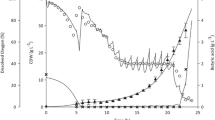Abstract
Four automatic substrate feeding strategies were developed and investigated in this study to obtain rapid, repeatable, and reliable high cell densities of Pseudomonas putida KT2440 from glucose. Growth yield data of the key nutrients, Y X/Glucose, Y X/NH4, Y X/PO4, Y X/Mg, and Y CO2/Glucose, were determined to be 0.41, 5.44, 13.70, 236, and 0.65 g g−1, respectively. Although standard exponential feeding strategy worked well when the predetermined μ was set at 0.25 h−1, an exponential glucose feeding strategy with online μ max estimation resulted in a higher average biomass productivity (3.4 vs 2.8 g l−1 h−1). A CO2 production rate based pulse glucose feeding strategy also resulted in good overall productivity (3.0 g l−1 h−1) and can be used as an alternative to pH-stat or DO-stat feeding. A cumulative CO2 production based continuous feed with real-time cumulative glucose consumption estimation resulted in much higher biomass productivity (4.3 g l−1 h−1) and appears to be an excellent and reliable approach to fully automating high-cell-density fed-batch cultivation of P. putida.






Similar content being viewed by others
References
Clesceri LS, Greenberg AE, Eaton AD (1999) Standard methods for the examination of water and wastewater, 20th edn. American Public Health Association, Washington, DC
Cutayar JM, Poillon D (1989) High cell density culture of Escherichia coli in a fed batch system with dissolved-oxygen as substrate feed indicator. Biotechnol Lett 11:155–160
Diniz SC, Taciro MK, Gomez JG, da Cruz Pradella JG (2004) High-cell-density cultivation of Pseudomonas putida IPT 046 and medium-chain-length polyhydroxyalkanoate production from sugarcane carbohydrates. Appl Biochem Biotechnol 119:51–70
Galan B, Diaz E, Garcia JL (2000) Enhancing desulphurization by engineering a flavin reductase-encoding gene cassette in recombinant biocatalysts. Environ Microbiol 2:687–694
Givskov M, Eberl L, Moller S, Poulsen LK, Molin S (1994) Responses to nutrient starvation in Pseudomonas putida KT2442—analysis of general cross-protection, cell-shape, and macromolecular content. J Bacteriol 176:7–14
Hofer H, Mandl T, Steiner W (2002) Acetopyruvate hydrolase production by Pseudomonas putida O1—optimization of batch and fed-batch fermentations. Appl Microbiol Biotechnol 60:293–299
Huijberts GNM, Eggink G, Dewaard P, Huisman GW, Witholt B (1992) Pseudomonas putida KT2442 cultivated on glucose accumulates poly(3-hydroxyalkanoates) consisting of saturated and unsaturated monomers. Appl Environ Microbiol 58:536–544
Kim BS (2002) Production of medium chain length polyhydroxyalkanoates by fed-batch culture of Pseudomonas oleovorans. Biotechnol Lett 24:125–130
Kim BS, Lee SC, Lee SY, Chang YK, Chang HN (2004) High cell density fed-batch cultivation of Escherichia coli using exponential feeding combined with pH-stat. Bioprocess Biosyst Eng 26:147–150
Kim GJ, Lee IY, Choi DK, Yoon SC, Park YH (1996) High cell density cultivation of Pseudomonas putida BM01 using glucose. J Microbiol Biotechnol 6:221–224
Lee J, Lee SY, Park S, Middelberg APJ (1999) Control of fed-batch fermentations. Biotechnol Adv 17:29–48
Lee SY, Wong HH, Choi JI, Lee SH, Lee SC, Han CS (2000) Production of medium-chain-length polyhydroxyalkanoates by high-cell-density cultivation of Pseudomonas putida under phosphorus limitation. Biotechnol Bioeng 68:466–470
Lever M (1972) New reaction for colorimetric determination of carbohydrates. Anal Biochem 47:273–279
Nelson KE, Weinel C, Paulsen IT, Dodson RJ, Hilbert H, Martins dos Santos VA, Fouts DE, Gill SR, Pop M, Holmes M, Brinkac L, Beanan M, DeBoy RT, Daugherty S, Kolonay J, Madupu R, Nelson W, White O, Peterson J, Khouri H, Hance I, Chris Lee P, Holtzapple E, Scanlan D, Tran K, Moazzez A, Utterback T, Rizzo M, Lee K, Kosack D, Moestl D, Wedler H, Lauber J, Stjepandic D, Hoheisel J, Straetz M, Heim S, Kiewitz C, Eisen JA, Timmis KN, Dusterhoft A, Tummler B, Fraser CM (2002) Complete genome sequence and comparative analysis of the metabolically versatile Pseudomonas putida KT2440. Environ Microbiol 4:799–808
Pirt SJ (1975) Principles of microbe and cell cultivation. Blackwell, Oxford
Riesenberg D (1991) High-cell-density cultivation of Escherichia coli. Curr Opin Biotechnol 2:380–384
Riesenberg D, Guthke R (1999) High-cell-density cultivation of microorganisms. Appl Microbiol Biotechnol 51:422–430
Riesenberg D, Schulz V, Knorre WA, Pohl HD, Korz D, Sanders EA, Ross A, Deckwer WD (1991) High cell density cultivation of Escherichia coli at controlled specific growth rate. J Biotechnol 20:17–28
Rojo F, Pieper DH, Engesser KH, Knackmuss HJ, Timmis KN (1987) Assemblage of ortho cleavage route for simultaneous degradation of chloro- and methylaromatics. Science 238:1395–1398
Suzuki T, Yamane T, Shimizu S (1990) Phenomenological background and some preliminary trials of automated substrate supply in pH-stat modal fed-batch culture using a setpoint of high limit. J Ferment Bioeng 69:292–297
Tada K, Kishimoto M, Omasa T, Katakura Y, Suga KI (2000) l-lysine production by exponential feeding of l-threonine. J Biosci Bioeng 90:669–674
Thuesen MH, Norgaard A, Hansen AM, Caspersen MB, Christensen HE (2003) Expression of recombinant Pseudomonas stutzeri di-heme cytochrome c4 by high-cell-density fed-batch cultivation of Pseudomonas putida. Protein Expr Purif 27:175–181
Timmis KN (2002) Pseudomonas putida: a cosmopolitan opportunist par excellence. Environ Microbiol 4:779–781
Weatherburn MW (1967) Phenol–hypochlorite reaction for determination of ammonia. Anal Chem 39:971–974
Yoon SK, Kang WK, Park TH (1994) Fed-batch operation of recombinant Escherichia coli containing Trp promoter with controlled specific growth rate. Biotechnol Bioeng 43:995–999
Acknowledgement
This project was supported by the Natural Science and Engineering Research Council of Canada (NSERC).
Author information
Authors and Affiliations
Corresponding author
Rights and permissions
About this article
Cite this article
Sun, Z., Ramsay, J.A., Guay, M. et al. Automated feeding strategies for high-cell-density fed-batch cultivation of Pseudomonas putida KT2440. Appl Microbiol Biotechnol 71, 423–431 (2006). https://doi.org/10.1007/s00253-005-0191-7
Received:
Revised:
Accepted:
Published:
Issue Date:
DOI: https://doi.org/10.1007/s00253-005-0191-7




